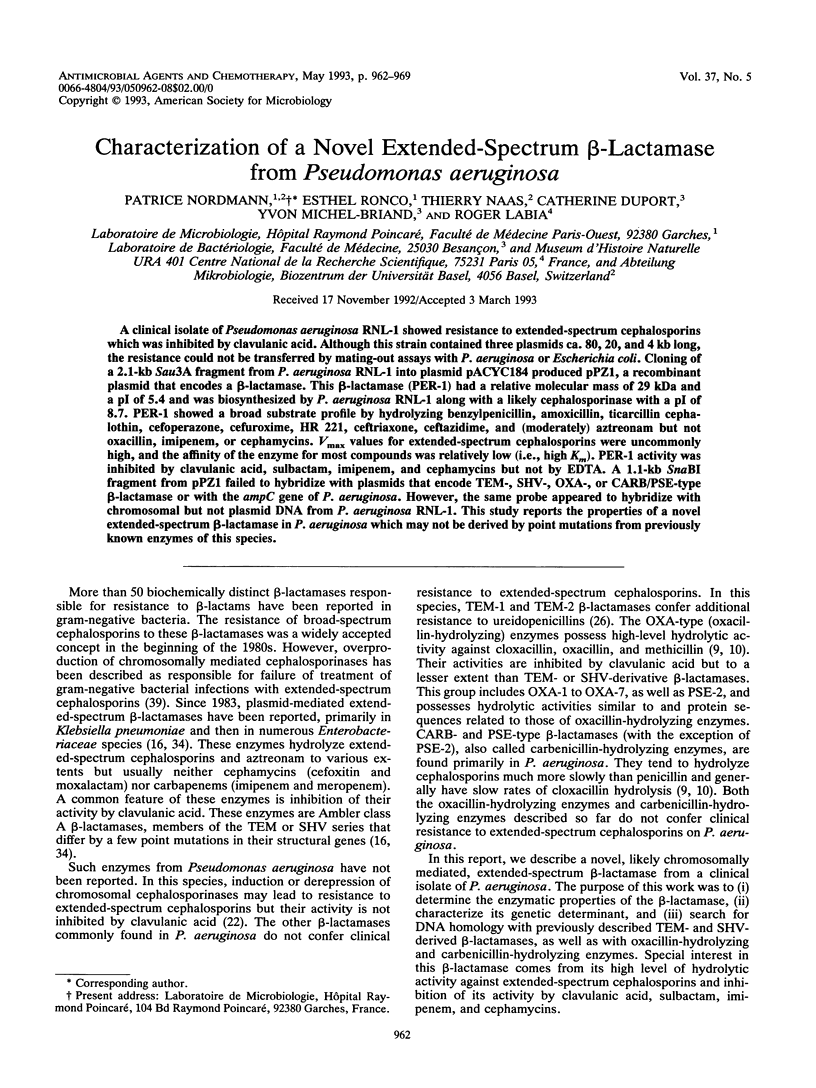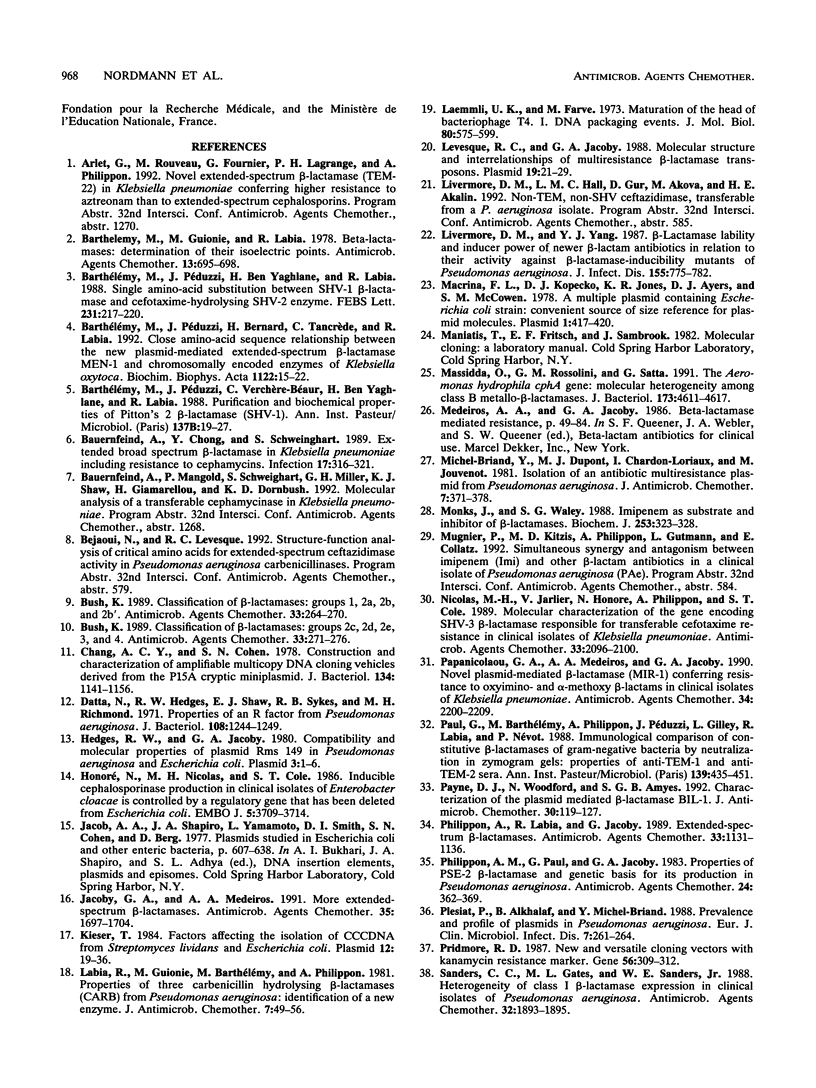Abstract
A clinical isolate of Pseudomonas aeruginosa RNL-1 showed resistance to extended-spectrum cephalosporins which was inhibited by clavulanic acid. Although this strain contained three plasmids ca. 80, 20, and 4 kb long, the resistance could not be transferred by mating-out assays with P. aeruginosa or Escherichia coli. Cloning of a 2.1-kb Sau3A fragment from P. aeruginosa RNL-1 into plasmid pACYC184 produced pPZ1, a recombinant plasmid that encodes a beta-lactamase. This beta-lactamase (PER-1) had a relative molecular mass of 29 kDa and a pI of 5.4 and was biosynthesized by P. aeruginosa RNL-1 along with a likely cephalosporinase with a pI of 8.7. PER-1 showed a broad substrate profile by hydrolyzing benzylpenicillin, amoxicillin, ticarcillin cephalothin, cefoperazone, cefuroxime, HR 221, ceftriaxone, ceftazidime, and (moderately) aztreonam but not oxacillin, imipenem, or cephamycins. Vmax values for extended-spectrum cephalosporins were uncommonly high, and the affinity of the enzyme for most compounds was relatively low (i.e., high Km). PER-1 activity was inhibited by clavulanic acid, sulbactam, imipenem, and cephamycins but not by EDTA. A 1.1-kb SnaBI fragment from pPZ1 failed to hybridize with plasmids that encode TEM-, SHV-, OXA-, or CARB/PSE-type beta-lactamase or with the ampC gene of P. aeruginosa. However, the same probe appeared to hybridize with chromosomal but not plasmid DNA from P. aeruginosa RNL-1. This study reports the properties of a novel extended-spectrum beta-lactamase in P. aeruginosa which may not be derived by point mutations from previously known enzymes of this species.
Full text
PDF







Images in this article
Selected References
These references are in PubMed. This may not be the complete list of references from this article.
- Barthelemy M., Guionie M., Labia R. Beta-lactamases: determination of their isoelectric points. Antimicrob Agents Chemother. 1978 Apr;13(4):695–698. doi: 10.1128/aac.13.4.695. [DOI] [PMC free article] [PubMed] [Google Scholar]
- Barthélémy M., Peduzzi J., Verchère-Beaur C., Ben Yaghlane H., Labia R. Purification and biochemical properties of Pitton's type 2 beta-lactamase (SHV-1). Ann Inst Pasteur Microbiol. 1986 Jul-Aug;137B(1):19–27. doi: 10.1016/s0769-2609(86)80090-4. [DOI] [PubMed] [Google Scholar]
- Barthélémy M., Péduzzi J., Ben Yaghlane H., Labia R. Single amino acid substitution between SHV-1 beta-lactamase and cefotaxime-hydrolyzing SHV-2 enzyme. FEBS Lett. 1988 Apr 11;231(1):217–220. doi: 10.1016/0014-5793(88)80734-8. [DOI] [PubMed] [Google Scholar]
- Barthélémy M., Péduzzi J., Bernard H., Tancrède C., Labia R. Close amino acid sequence relationship between the new plasmid-mediated extended-spectrum beta-lactamase MEN-1 and chromosomally encoded enzymes of Klebsiella oxytoca. Biochim Biophys Acta. 1992 Jul 13;1122(1):15–22. doi: 10.1016/0167-4838(92)90121-s. [DOI] [PubMed] [Google Scholar]
- Bauernfeind A., Chong Y., Schweighart S. Extended broad spectrum beta-lactamase in Klebsiella pneumoniae including resistance to cephamycins. Infection. 1989 Sep-Oct;17(5):316–321. doi: 10.1007/BF01650718. [DOI] [PubMed] [Google Scholar]
- Bush K. Classification of beta-lactamases: groups 1, 2a, 2b, and 2b'. Antimicrob Agents Chemother. 1989 Mar;33(3):264–270. doi: 10.1128/aac.33.3.264. [DOI] [PMC free article] [PubMed] [Google Scholar]
- Bush K. Classification of beta-lactamases: groups 2c, 2d, 2e, 3, and 4. Antimicrob Agents Chemother. 1989 Mar;33(3):271–276. doi: 10.1128/aac.33.3.271. [DOI] [PMC free article] [PubMed] [Google Scholar]
- Chang A. C., Cohen S. N. Construction and characterization of amplifiable multicopy DNA cloning vehicles derived from the P15A cryptic miniplasmid. J Bacteriol. 1978 Jun;134(3):1141–1156. doi: 10.1128/jb.134.3.1141-1156.1978. [DOI] [PMC free article] [PubMed] [Google Scholar]
- Datta N., Hedges R. W., Shaw E. J., Sykes R. B., Richmond M. H. Properties of an R factor from Pseudomonas aeruginosa. J Bacteriol. 1971 Dec;108(3):1244–1249. doi: 10.1128/jb.108.3.1244-1249.1971. [DOI] [PMC free article] [PubMed] [Google Scholar]
- Hedges R. W., Jacoby G. A. Compatibility and molecular properties of plasmid Rms 149 in Pseudomonas aeruginosa and Escherichia coli. Plasmid. 1980 Jan;3(1):1–6. doi: 10.1016/s0147-619x(80)90029-3. [DOI] [PubMed] [Google Scholar]
- Honoré N., Nicolas M. H., Cole S. T. Inducible cephalosporinase production in clinical isolates of Enterobacter cloacae is controlled by a regulatory gene that has been deleted from Escherichia coli. EMBO J. 1986 Dec 20;5(13):3709–3714. doi: 10.1002/j.1460-2075.1986.tb04704.x. [DOI] [PMC free article] [PubMed] [Google Scholar]
- Jacoby G. A., Medeiros A. A. More extended-spectrum beta-lactamases. Antimicrob Agents Chemother. 1991 Sep;35(9):1697–1704. doi: 10.1128/aac.35.9.1697. [DOI] [PMC free article] [PubMed] [Google Scholar]
- Kieser T. Factors affecting the isolation of CCC DNA from Streptomyces lividans and Escherichia coli. Plasmid. 1984 Jul;12(1):19–36. doi: 10.1016/0147-619x(84)90063-5. [DOI] [PubMed] [Google Scholar]
- Labia R., Guionie M., Barthélémy M. Properties of three carbenicillin-hydrolysing beta-lactamases (CARB) from Pseudomonas aeruginosa: identification of a new enzyme. J Antimicrob Chemother. 1981 Jan;7(1):49–56. doi: 10.1093/jac/7.1.49. [DOI] [PubMed] [Google Scholar]
- Laemmli U. K., Favre M. Maturation of the head of bacteriophage T4. I. DNA packaging events. J Mol Biol. 1973 Nov 15;80(4):575–599. doi: 10.1016/0022-2836(73)90198-8. [DOI] [PubMed] [Google Scholar]
- Levesque R. C., Jacoby G. A. Molecular structure and interrelationships of multiresistance beta-lactamase transposons. Plasmid. 1988 Jan;19(1):21–29. doi: 10.1016/0147-619x(88)90059-5. [DOI] [PubMed] [Google Scholar]
- Livermore D. M., Yang Y. J. Beta-lactamase lability and inducer power of newer beta-lactam antibiotics in relation to their activity against beta-lactamase-inducibility mutants of Pseudomonas aeruginosa. J Infect Dis. 1987 Apr;155(4):775–782. doi: 10.1093/infdis/155.4.775. [DOI] [PubMed] [Google Scholar]
- Macrina F. L., Kopecko D. J., Jones K. R., Ayers D. J., McCowen S. M. A multiple plasmid-containing Escherichia coli strain: convenient source of size reference plasmid molecules. Plasmid. 1978 Jun;1(3):417–420. doi: 10.1016/0147-619x(78)90056-2. [DOI] [PubMed] [Google Scholar]
- Massidda O., Rossolini G. M., Satta G. The Aeromonas hydrophila cphA gene: molecular heterogeneity among class B metallo-beta-lactamases. J Bacteriol. 1991 Aug;173(15):4611–4617. doi: 10.1128/jb.173.15.4611-4617.1991. [DOI] [PMC free article] [PubMed] [Google Scholar]
- Michel-Briand Y., Dupont M. J., Chardon-Loriaux I., Jouvenot M. Isolation of an antibiotic multiresistance plasmid from Pseudomonas aeruginosa. J Antimicrob Chemother. 1981 Apr;7(4):371–378. doi: 10.1093/jac/7.4.371. [DOI] [PubMed] [Google Scholar]
- Monks J., Waley S. G. Imipenem as substrate and inhibitor of beta-lactamases. Biochem J. 1988 Jul 15;253(2):323–328. doi: 10.1042/bj2530323. [DOI] [PMC free article] [PubMed] [Google Scholar]
- Nicolas M. H., Jarlier V., Honore N., Philippon A., Cole S. T. Molecular characterization of the gene encoding SHV-3 beta-lactamase responsible for transferable cefotaxime resistance in clinical isolates of Klebsiella pneumoniae. Antimicrob Agents Chemother. 1989 Dec;33(12):2096–2100. doi: 10.1128/aac.33.12.2096. [DOI] [PMC free article] [PubMed] [Google Scholar]
- Papanicolaou G. A., Medeiros A. A., Jacoby G. A. Novel plasmid-mediated beta-lactamase (MIR-1) conferring resistance to oxyimino- and alpha-methoxy beta-lactams in clinical isolates of Klebsiella pneumoniae. Antimicrob Agents Chemother. 1990 Nov;34(11):2200–2209. doi: 10.1128/aac.34.11.2200. [DOI] [PMC free article] [PubMed] [Google Scholar]
- Paul G., Barthélémy M., Philippon A., Peduzzi J., Gilly L., Labia R., Névot P. Immunological comparison of constitutive beta-lactamases of gram-negative bacteria by neutralization in zymogram gels: properties of anti-TEM-1 and anti-TEM-2 sera. Ann Inst Pasteur Microbiol. 1988 Jul-Aug;139(4):435–451. [PubMed] [Google Scholar]
- Payne D. J., Woodford N., Amyes S. G. Characterization of the plasmid mediated beta-lactamase BIL-1. J Antimicrob Chemother. 1992 Aug;30(2):119–127. doi: 10.1093/jac/30.2.119. [DOI] [PubMed] [Google Scholar]
- Philippon A. M., Paul G. C., Jacoby G. A. Properties of PSE-2 beta-lactamase and genetic basis for its production in Pseudomonas aeruginosa. Antimicrob Agents Chemother. 1983 Sep;24(3):362–369. doi: 10.1128/aac.24.3.362. [DOI] [PMC free article] [PubMed] [Google Scholar]
- Philippon A., Labia R., Jacoby G. Extended-spectrum beta-lactamases. Antimicrob Agents Chemother. 1989 Aug;33(8):1131–1136. doi: 10.1128/aac.33.8.1131. [DOI] [PMC free article] [PubMed] [Google Scholar]
- Plesiat P., Alkhalaf B., Michel-Briand Y. Prevalence and profiles of plasmids in Pseudomonas aeruginosa. Eur J Clin Microbiol Infect Dis. 1988 Apr;7(2):261–264. doi: 10.1007/BF01963098. [DOI] [PubMed] [Google Scholar]
- Pridmore R. D. New and versatile cloning vectors with kanamycin-resistance marker. Gene. 1987;56(2-3):309–312. doi: 10.1016/0378-1119(87)90149-1. [DOI] [PubMed] [Google Scholar]
- Sanders C. C., Gates M. L., Sanders W. E., Jr Heterogeneity of class I beta-lactamase expression in clinical isolates of Pseudomonas aeruginosa. Antimicrob Agents Chemother. 1988 Dec;32(12):1893–1895. doi: 10.1128/aac.32.12.1893. [DOI] [PMC free article] [PubMed] [Google Scholar]
- Sanders W. E., Jr, Sanders C. C. Inducible beta-lactamases: clinical and epidemiologic implications for use of newer cephalosporins. Rev Infect Dis. 1988 Jul-Aug;10(4):830–838. doi: 10.1093/clinids/10.4.830. [DOI] [PubMed] [Google Scholar]
- Southern E. M. Detection of specific sequences among DNA fragments separated by gel electrophoresis. J Mol Biol. 1975 Nov 5;98(3):503–517. doi: 10.1016/s0022-2836(75)80083-0. [DOI] [PubMed] [Google Scholar]
- Stanisich V. A., Ortiz J. M. Similarities between plasmids of the P-incompatibility group derived from different bacterial genera. J Gen Microbiol. 1976 Jun;94(2):281–289. doi: 10.1099/00221287-94-2-281. [DOI] [PubMed] [Google Scholar]
- Watanabe M., Iyobe S., Inoue M., Mitsuhashi S. Transferable imipenem resistance in Pseudomonas aeruginosa. Antimicrob Agents Chemother. 1991 Jan;35(1):147–151. doi: 10.1128/aac.35.1.147. [DOI] [PMC free article] [PubMed] [Google Scholar]
- Witchitz J. L., Chabbert Y. A. Résistance transférable à la gentamicine I. Expression du caractère de résistance. Ann Inst Pasteur (Paris) 1971 Dec;121(6):733–742. [PubMed] [Google Scholar]
- Wu S. W., Dornbusch K., Norgren M., Kronvall G. Extended spectrum beta-lactamase from Klebsiella oxytoca, not belonging to the TEM or SHV family. J Antimicrob Chemother. 1992 Jul;30(1):3–16. doi: 10.1093/jac/30.1.3. [DOI] [PubMed] [Google Scholar]
- Yanisch-Perron C., Vieira J., Messing J. Improved M13 phage cloning vectors and host strains: nucleotide sequences of the M13mp18 and pUC19 vectors. Gene. 1985;33(1):103–119. doi: 10.1016/0378-1119(85)90120-9. [DOI] [PubMed] [Google Scholar]




